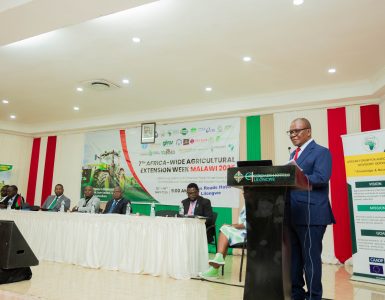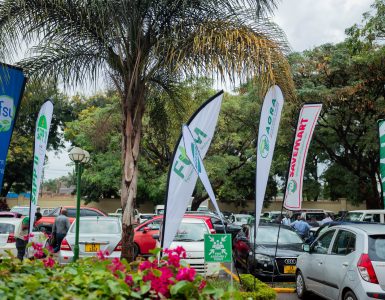FOOD INSECURITY GROWS AS COVID-19 SPREADS ACROSS AFRICA
Grace Musimami
The Alliance for Green Revolution in African AGRA has launched a situation report bringing together timely information from its headquarter and country offices on what is unfolding. The reports reflect the voices of smallholder farmers and SMEs “on the ground “, Governments and continental partners.
According to Andrew Cox, chief of staff and strategy at AGRA Head offices in Nairobi, AGRA will be rolling out a number of communication products during this pandemic period to guide Farmers, business leaders, and policymakers on information-based decision making.
“While there are many information products on COVID-19 out there, we do hope that this adds value from the point of view of African agriculture and food security.” Adds Andrew Cox.

Andrew further explains that as the COVID-19 pandemic continues to spread across the African continent, its implications are spreading beyond the health crisis. It has economic ramifications and is already impacting food security across Africa. In this challenging context, AGRA and its partners continue to partner with governments, smallholder farmers, continental bodies, businesses, and with implementing and development partners to build the resilience of Africa’s agriculture and food systems.
The current communication products disseminated include a dedicated COVID-19 microsite that features thought pieces and guidelines developed in light of the crisis and a regular situation report which is available on AGRA’s COVID-19 website.
AGRA is also supplementing the weekly SitRep with occasional briefing notes that are led by technical colleagues, curated to widen awareness of the threat that COVID-19 brings to African food security and agriculture, and share solutions and mitigating measures.
As with all shocks, the poor are the most vulnerable and it is disrupting the livelihoods of small and medium businesses and the many low-income households across the continent. In this challenging context, AGRA continues to partner with smallholder farmers and agribusinesses to strengthen the resilience of food systems while providing critical guidance to African governments for decision making.
The weekly situation report is designed to be a source of information for governments and donors, bringing together timely information from AGRA’s teams on-the-ground who are close to smallholder farmers and SMEs with insights into government mobilization and financial support given to countries by donor institutions.
The report is structured to first provide highlights of the situation on-the-ground followed by more in-depth information into the situation in specific regions across sub-Saharan Africa as well as AGRA’s response. Highlights from AGRA’s Monthly Food Monitor are also included. Annexes provide COVID-19 / agriculture information and response at a glance by country, and a round-up of financial resources committed to date, based on data available to AGRA.
In the recent situation report, AGRA has reported an increase in food insecurity in Africa,
Food insecurity grows. Food insecurity has continued to rise across Africa. In AGRA’s program focus countries1, based on publicly available information and data supplied from government ministries, we see this increasing from around 25 million people in May to 28 million people by September. In Ethiopia for example, the government has projected that food production in the upcoming season could be lower by 8% due to the COVID-19 crisis.
Government-mandated safety measures to mitigate the spread of COVID-19, such as increased health at security checks at borders, and restriction of movement, continue to impact farmers’ ability to harvest and sell their crops outside of their local areas. In East Africa, farmers are still feeling the impact of locust invasions, while eradication efforts continue. Ongoing flood conditions in Kenya and Uganda are shortening the planting season. However, the high rainfalls have also created an opportunity for “dry season” crops using the abundant residual moisture. In Southern Africa, recurring climate shocks are significantly contributing to reduced food production and driving staple food prices up.
The UN has increased its original appeal for COVID-19 response funds from $2 billion in mid-March to $6.7 billion in mid-May, as humanitarian experts have noted the acceleration of the food insecurity crisis.
David Beasely, Executive Director of the World Food Programme warned in April “I was already saying that 2020 would be the worst year since the second world war” Already, the COVID-19 pandemic, has “taken us to the uncharted territory”, he said. “Now …. We are looking at widespread famines of biblical proportions.”
Restrictions due to safety concerns around COVID-19 pose challenges for farmers selling their harvests. Government-mandated restrictions around the movement of people and the need for social distancing continues to pose challenges for farmers, especially in Southern Africa, where countries are in the harvest season and workers must gather for harvesting, cleaning and packing crops for transport. To address these challenges, some farmers and traders are using social media and farm-based sales to bridge production and market gaps during the pandemic. Kenya is leading the way in these efforts. Post-harvest training, which help farmers meeting international quality standards, are being conducted via digital platforms through village based organizations. In Rwanda, AGRA has partnered with others to expand mechanization so as to reduce manual labor requirements and thus enable social distancing.
Governments have classified agriculture as essential. Over the last few weeks, while governments have moved ahead with measures such as social distancing, handwashing and border closures, they have also classified agriculture inputs and activities as essential across all AGRA focus countries. However, health and security checks at border posts continue to cause long delays to the delivery of inputs and movement of food within and between countries. Furthermore, the different approaches followed by national governments are starting to create friction leading to border closures that curtail trade. At the same time those which applied strict lock-downs are also starting to ease those measures.
Many governments are providing relief to farmers and some have accelerated subsidy programs, supported by multilateral organizations (see Annex for current commitments to spending). Governments in all AGRA focus countries are supporting farmers and vulnerable communities through various mechanisms including input subsidies, grain purchase and relief programs. In Ghana, Mali, and Nigeria, for example, governments have accelerated input subsidy programs to ensure farmers are able to obtain inputs in a timely manner. In Malawi, where farmers are currently harvesting their crops, the government has instituted a cereal purchase program. Financial resources from multilateral donors to mitigate the impact of the pandemic have also increased in the last month and now amount to approximately $4.2BN according to publicly available data available to AGRA. Not counted in this total is $10BN in resources identified by the African Development Bank Group that can be made available for member countries impacted by COVID-19.
As East and West Africa enter the planting season, access to inputs is critical.
In West Africa, conditions have been favorable for another good harvest for the region that will contribute to sustain low prices and enhance availability and access to food. In East Africa, heavy rains and the desert locust upsurge in the first half of 2020 could lead to significant crop losses. In Ethiopia the government estimates show that the over 350,000 mt of grain has been lost by desert locust invasion and it has left over a million people food insecure. The COVID-19 pandemic has threatened to disrupt agricultural food systems and might impact on expected production levels. However, in Tanzania, the Minister in his budget speech, announced that total food harvest from the two main seasons ending in July 2020, will enable 118% food self-sufficiency. (The graphic below illustrates the main crop seasons for countries in sub-Saharan Africa).

For full report contact : sitreps@agra.org OR Visit AGRA Website





Add comment